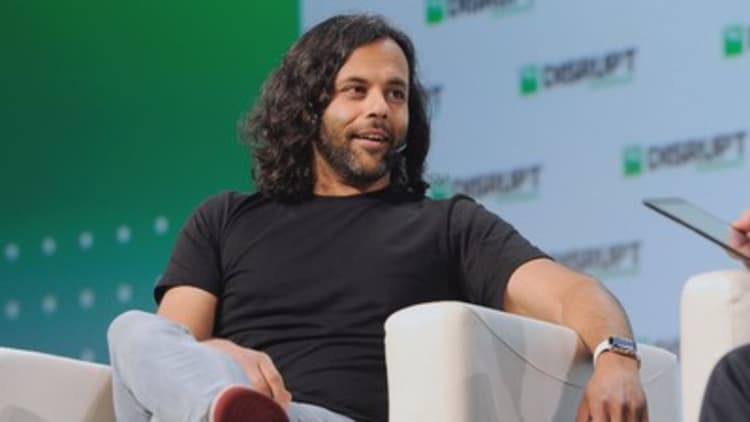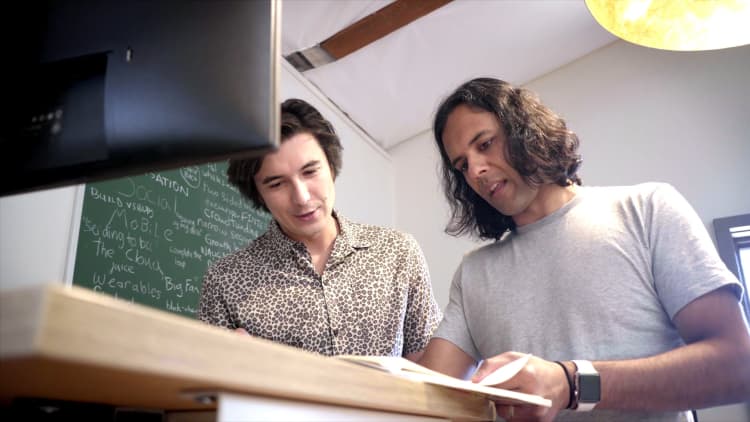
Popular stock trading app Robinhood, which disrupted Wall Street with zero-fee transactions, is taking aim at an even bigger market: banks.
The 5-year-old company on Thursday unveiled "Robinhood Checking & Savings," which offers checking and savings accounts with no fees and pays an interest rate roughly 30 times the national average. Customers will earn 3 percent annually on money in either accounts, paid out on a daily basis.
"We as a company are going make the financial services industry more inclusive and are going to do it with zero commissions, a lower cost structure, and by relentlessly automating and building an engineering-first company," Robinhood co-CEO Baiju Bhatt told CNBC. "We're charging no fees, period."
The no-fee model is what you might expect from Robinhood. The Menlo Park, California-based company took Wall Street brokerages by storm by offering stock trading for free. The model put pressure on incumbents like Charles Schwab and TD Ameritrade, which charge $4.95 and $6.95, respectively, for equity trades.

That price war is still intensifying. J.P. Morgan Chase unveiled its own free trading app in August, sending shares of TD Ameritrade and other public online brokers lower that day.
Robinhood is now taking the disruptive no-fee model to checking and savings accounts, a fundamental way retail banks make money. But there's an important distinction between what the start-up is offering and a traditional bank: the Robinhood savings account is SIPC-insured, not FDIC-insured, which means the customer is essentially opening a brokerage account that has different protections.
Banks use customer deposits to make loans and to profit from account fees, ATM fees, penalty charges and foreign transaction fees — none of which exist in Robinhood's model. Thursday's announcement launches the fintech company further into the consumer banking ring with Wall Street heavyweights like Bank of America, Wells Fargo and CitiGroup.
How will they make money?
Robinhood's rate is well-above the average 0.08 percent yield on U.S. checking accounts and the 0.1 percent average on savings accounts, according to the latest data from Bankrate.com. Goldman Sachs' consumer banking arm, Marcus, is one of the highest-yielding banks in the savings products category with a 2.05 percent annual percentage yield.
"If we roll this product out, and it's adopted by millions who love it and use, we will have one of the fastest growing financial services companies in history," Bhatt said.
Robinhood saw massive growth in 2018 alone, jumping from 5 million to 6 million customers in a matter of months and was recently valued at $5.6 billion.
Bhatt, who co-founded Robinhood in 2013 with Vlad Tenev, said the yield is not a "teaser rate." Given the direction from the Federal Reserve, which is slowly raising interest rates, Bhatt said the 3 percent rate should be sustainable.
They are not necessarily going to make money on these checking and savings products right away. Robinhood is taking a page out of Amazon's playbook by shunning profits for growth.
"Amazon built an entire business around a strategy that makes that long-term investments in financial services," Bhatt said. "We fully intend to make money off of this but we do not need it to be profitable on day one."
The start-up will split revenue from debit card transactions in a partnership with Mastercard. It will also earn interest off customer assets it holds, which are invested in government-grade securities like U.S. Treasurys.
For stock trades, it generates revenue by taking a fraction of a cent per dollar from each trade order as well as collecting interest on customer deposits. Robinhood also makes money on a paid subscription service called Robinhood Gold, launched in September 2016.
Robinhood has faced criticism over its revenue model, especially considering its founding ethos, which some have categorized as "anti-Wall Street." According to a report from Bloomberg, the company makes almost half of its revenue from selling its customers' orders to high-frequency trading firms, or market makers, like Citadel Securities. The practice, known as payment for order flow, is not uncommon on Wall Street. Almost all retail brokerages employ it.
Robinhood issued a statement after the report, saying like the rest of the industry, it "participates in rebate programs which help customers get additional price improvement for their orders by creating competition amongst the exchanges and liquidity providers who fill the orders, often resulting in superior execution quality."
Robinhood also said in the statement it does not sell personally identifiable data of any kind to execution venues.
"Robinhood does not, has not, and will not sell customer information," the company said.

Beyond the 'cool factor'
In a low-interest rate environment, even nonmillennial customers are hungry for any sort of yield. The higher-than-average rate could usher in a new age group that doesn't typically care about a "cool" factor associated with Robinhood, Bhatt said.
"We started [the] company with idea that we could make investing accessible to a younger audience," Bhatt said. "Today it's less tightly concentrated among millennials."
The company is launching an entirely new app on Thursday that will house its stock trading alongside the checking and savings accounts. Robinhood's debit cards with Mastercard will be available in January on a first-come, first-serve and are being rolled out in a limited amount. Robinhood also partnered with Costco, Walgreens and CVS among others to give customers access to 75,000 free ATMS across the country.
The announcement, which had been two years in the making, is possible in large part because of its regulatory status. The company is a member of FINRA, a Securities and Exchange Commission registered broker-dealer, and is a member of the Securities Investor Protection Corporation, or SIPC. Robinhood accounts are SIPC-insured up to $250,000 but the agency does not guarantee customers would get their money back in every situation. Assets can be backed by one of the agencies — either the FDIC or SIPC — but not both.
Its recent self-clearing announcement was another way to cut costs by getting rid of a key middleman and set Robinhood up to be able to scale faster and expand into more areas of financial services, Bhatt said.
The company has been open about its ambitions. Bhatt has said going public is something "we think is very much in the future." In November, Robinhood hired Amazon veteran Jason Warnick as its first-ever chief financial officer.
"Five to 10 years from now, you should be able to open up Robinhood and get anything you could get by walking into your local Bank of America, with a better customer experience and better pricing," Tenev told CNBC in October.


